Companies that have adopted Agile Scrum have experienced an average growth of 60% in revenue and profit. The Agile approach is now being used by at least 71% of companies in the United States. These facts give a clear picture of how popular the Agile Scrum methodology has become.
In the Agile approach, the development process of websites, mobile apps, and web apps involves several teams from different departments working simultaneously. An objective way to measure progress and identify areas for improvement is needed to communicate their progress and identify potential issues before they become major problems. This is where Scrum Metrics comes into play.
What is Scrum?
Scrum is a lightweight framework designed to help control and track projects to ensure successful execution and completion. It assists teams and organizations in creating value through adaptive solutions for complex problems.
The Scrum framework has a set of defined roles, responsibilities, and events to streamline the process. It follows an iterative approach that includes sprints, which usually last from one to four weeks, allowing the self-organizing team to regularly demonstrate the product vision.
What are Agile Scrum Metrics?
Metrics are measurements used to track the performance of businesses and teams in various fields. They are an essential tool for planning, tracking, and monitoring the functioning and progress of projects and teams. Metrics help identify crucial gaps within individuals, teams, and organizations, allowing for a proactive resolution to ensure smooth execution.
Key Performance Indicators (KPIs) are metrics that indicate if a team is improving and performing in the desired direction. Metrics also help isolate problems and improve team performance to produce quality deliverables. Effective metrics keep the project team and customers aligned and on the same page.
Why Use Scrum Metrics?
Scrum Metrics provide an efficient way for the scrum master to monitor project progress, identify and resolve issues early, and complete project milestones within the defined time frame.
Instant delivery is a critical aspect of Agile, making quality a top priority in Agile Scrum projects. Tracking software quality and team performance is crucial, and that’s where metrics come in handy. They help measure software quality, team performance, and individual progress, making it a continuous improvement (CI) process. Metrics empower the team to be self-sufficient and seamlessly incorporate CI into their daily work.
Important Agile Scrum Metrics
Let’s have a brief walkthrough of important agile Scrum Metrics.
1. Sprint Burndown Report
This report is easy to understand and crucial for monitoring sprint progress. The Sprint Burndown Report provides a graphical representation of the remaining work in the sprint. As sprints are time-bound events, it is essential to continually track progress. The goal is to finish the sprint backlog at the end of the sprint. This metric is useful for the Scrum Master to determine if the team is on the right track or if they need any help to reach the target.
The graph is plotted with:
- Time on the X-axis
- Remaining work on the Y-axis, which is measured in either story points or hours.
Fig 1: Sprint Burndown Chart (Time vs Story points
 Sprint Burndown Chart (Time vs Estimated Days)
Sprint Burndown Chart (Time vs Estimated Days)
2. Team Velocity
Team velocity determines the work done by the team during a sprint. It helps to:
- Calculate team productivity
- Plan future sprints
- Forecast feature/project completion
Product owners find these metrics important to plan work for the team and communicate project timelines with respective stakeholders.
The graph is plotted with:
- Sprints on the X-axis
- Story points on the Y-axis
Fig 3: Team Velocity
3. Epic & Release Burndown
Epic and release burndown is a high-level overview of a larger piece of work. This burndown chart depicts the progress of versions and epics. A sprint comprises several epic and version activities, so tracking this is also essential. This chart enables the team to visualize the bigger picture of progress toward completion.
The graph is plotted with:
- Sprints on the X-axis
- Story points on the Y-axis
 Fig 4: Epic & Release burndown
Fig 4: Epic & Release burndown
4. Escape Defects
Escape defect measurement and monitoring is one of the vital metrics in a project. This metric gives an idea of the deliverable/release quality by tracking the number of defects experienced by the user. Avoiding escape defects is key to customer satisfaction.
Effective ways of minimizing escape defects include:
- Testing the product end to end
- Regular brainstorming on reported escape defects to identify areas of improvement
5. Actual vs Completed Story Points (Commitment variance)
This metric is used to assess the commitment of the team. It calculates the committed story points (done during sprint planning) versus completed/burned story points while closing the sprint. By calculating this metric, the team can do a self-evaluation towards the accomplishment of set goal(s). Collecting and analyzing the data will help the team to understand the lowlights. Identification and improvement of weak areas will boost the team’s confidence.
Summary
Good metrics give insight into the performance and progress of the team and organization. Hence, mapping appropriate measurement techniques helps in improvement. Not restricting only to reports and charts, collecting customer feedback, conducting activities to strengthen communication within and across teams, and listening effectively will result in a permanent, fruitful outcome and improved project management processes.
eInfochips – an Arrow company has incorporated the Agile Scrum project execution methodology in our DevOps practices. This methodology has been widely used in the industry for over 15 years. By measuring and maintaining transparent Agile Scrum Metrics, we gain the trust of our customers and exhibit an attitude of continuous learning and improvement. Reach out to us for more information on DevOps Services.















